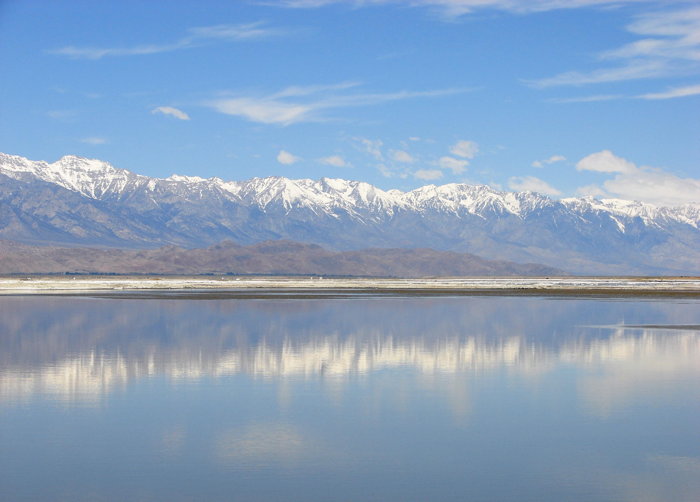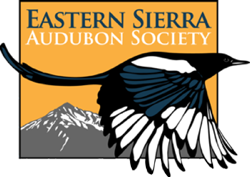Owens Lake Important Bird Area
Text and photos from National Audubon Society IBA Database Site Profile
Owens Lake Site Description
Owens Lake is a 100-square-mile terminal alkali playa at 3,600' elevation at the southern end of the Owens Valley, surrounded by the 14,000' southern Sierra Nevada on the west and the 11,000' Inyo Mtns. on the east. Historically, the lake would fill in winter and spring depending on rainfall, and support concentrations of waterbirds and shorebirds. After 1924, it was turned nearly dry year-round due to a massive network of water diversions associated with the Los Angeles Aqueduct. About a dozen wetlands supported by natural seeps or artesian wells surround the margin of the lakebed, generally on private property. Many of these are visible as large patches of green from Highway 395, the major thoroughfare through eastern California that skirts the western border of the lake. Except for a strip of land at the Owens River delta on the northern end, the entire lake bed is owned by the California State Lands Commission. Beginning in the 2000, Los Angeles has shallow flooded or ponded 25 square miles of the lake bed in order to control massive dust pollution (Clean Air Act requirement). This has led to a substantial increase in the acreage of wetland habitat on Owens Lake. By 2010, Los Angeles Dept. of Water and Power will add 9 square miles more of flooding and ponding. Updated by Eastern Sierra Audubon, September 2007.

Owens Lake Important Bird Area © Photo by Andrea Jones
Conservation Issues
Owens Lake may be thought of as a globally-important wetland in the making. Though the lakebed itself is probably reasonably secure from disturbance because of its public ownership and relative inaccessibility (surrounding private lands essentially block all public access), most of the conservation issues involve the private holdings along the margin of the lake. In addition, changes in dust control methods are possible that would use less water or no water and thereby destroy habitat recent re-created accidentally by the dust control project. Los Angeles in investigating the potential use of groundwater from under the lake which might impact flows of springs and artesian wells as well as water quality in newly created habitats. A massive water-bottling plant appeared on the southeast near Olancha, sits directly atop sensitive alkali wetland and riparian habitat. The ancient cottonwoods associated with the feeder streams on the western side of the lake, critical to breeding Swainson's Hawk and other riparian species, are almost entirely located on cattle ranches that have with the added conservation challenges involving grazing within riparian zones. Over 800 acres of enhanced wetlands are planned for the Owens River delta as part of the "Lower Owens River Project", which is once again flowing after 90 years (flows began in Dec. 2006). A 16,000 acre mineral lease in the western portion of the lake currently presents no threat to wildlife. As Owens Lake recovers, a main conservation challenge will involve treating the entire basin - feeder streams, meadows, marshes, and lake bed - as an integrated, inter-dependent ecosystem, similar to the now-famous situation at Mono Lake to the north.
Ornithological Summary
Owens Lake appears to be a major stop-over site for shorebirds and waterfowl in the southern California interior. Each spring and fall, brine flies on the lake support thousands of shorebirds, mainly Western and Least sandpipers, and thousands of ducks utilize the wetlands (especially the impoundments along the edges). An estimated 63,000 American Avocets stop at the lake during fall (Page and Ruhlen 2002). A wintering group of 300-400 Snow Geese winters here. Snowy Plover, alkali playa obligates in the interior of California, breed here in very high numbers (400-600 adults, G. Page, PRBO). Many of the alkali marsh birds associated with northeastern California breed here, including colonies of Yellow-headed Blackbird and, recently, Long-billed Curlew (1998 and 1999 only, fide T. and J. Heindel) and Wilson's Phalarope. It is likely that with continued increase of surface water on Owens Lake and the recovery of the wetland and meadow habitat, the avifauna will rebound dramatically.
Participate in a spring or fall Owens Lake Big Day to help census the growing numbers of birds using this IBA. See the last several years of spring count numbers compared here(pdf).
Help us learn more about the birds at this IBA! Enter your birding data online at California eBird! (http://ebird.org/california/)
Click here for a Bar Chart of eBird observations at Owens Lake


